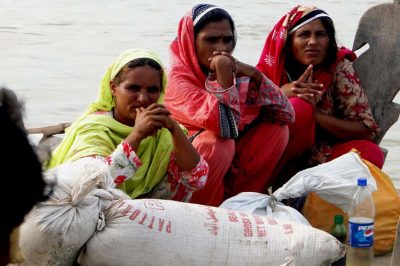In Pakistan’s arid landscapes, where the mighty Indus River weaves through its terrain, the gender dimensions of climate change paint a stark reality. According to recent data from the Pakistan Bureau of Statistics, women constitute 70% of the agricultural workforce. Yet they own merely 3% of the land—a sobering statistic that underscores the profound gender disparities. Around the globe, the impacts of climate change manifest differently for men and women, shaped by their distinct roles and responsibilities within households and communities.
This inequality extends to access to opportunities such as education and participation in political processes, further marginalizing women. Pakistan reflects these disparities vividly, with women bearing a disproportionate burden of climate change impacts. Particularly in rural areas, traditional gender roles intensify women’s vulnerability, amplifying challenges in accessing essential resources like water and firewood. This dynamic increases their workload and household responsibilities, exacerbating their vulnerability to the changing climate.
The impact of climate change has the potential to exacerbate existing gender disparities, mainly stemming from women’s limited access to resources, decision-making processes, and freedom of choice, all of which are constrained by pervasive patriarchal values and social norms. This emphasizes the imperative to address these gendered vulnerabilities and acknowledges the prevalence of patriarchal systems hindering women’s participation in adaptation and mitigation efforts across South Asian and HKH countries.
Moreover, alongside gender inequality, climate change compounds issues of food insecurity and poverty, amplifying the root causes of vulnerability to climate change. At the forefront of the most pressing ecological and environmental crisis lies climate change, its ramifications evident in droughts, floods, extreme weather events, and the spread of diseases, exacerbating global water and food insecurities. Among the 1.3 billion individuals affected worldwide, a significant portion comprises women, with approximately 80% displaced by climate-related disasters, as the United Nations Development Programme reported in 2015.
In a study conducted by Oxfam in 2019, titled “Climate-Induced Migration in Pakistan,” researchers examined the water crisis in the coastal districts of Sindh. They found that local women are compelled to travel an average distance of two kilometers daily to fetch water from wells and hand pumps, often making multiple trips per day. Concurrently, the shifting climate exacerbates existing gender disparities, further impoverishing communities and depriving them of essential opportunities and resources. Consequently, the combination of poverty, along with political and socio-economic marginalization, places women at a distinct disadvantage in coping with the adverse effects of climatic challenges.
Sindh, a predominantly agrarian province in Pakistan, hosts a substantial rural population. Women are integral to agricultural endeavors and household responsibilities. However, within the rigid social hierarchy and under the influence of elite landholders, coupled with cultural and religious constraints, rural women in Sindh are among the most marginalized members of society.
The impacts of climate change further compound challenges for female employment in Pakistan. In 2010-2011, 74.2% of working women were employed in the agricultural sector, compared to 34.7% of men. Women undertake crucial farming tasks such as sowing, transplanting, weeding, harvesting, and post-harvest operations, which include threshing, drying, storage, off-farm transportation, and marketing. In livestock rearing, women are responsible for fodder collection, animal care, dung cake preparation, processing animal products like cheese, butter, yogurt, and their subsequent marketing. As weather patterns undergo shifts, the vulnerability of women is projected to escalate.
While climate change poses challenges across various sectors of society, women are expected to bear a disproportionate burden due to their dual roles in production and reproduction. Historical evidence from past natural disasters underscores this vulnerability, particularly in Pakistan. For instance, during the devastating floods of 2010, a staggering number of women, totaling 713,000 in the age group of 15-49, along with 133,000 pregnant women, were directly impacted, highlighting their heightened susceptibility to such calamities.
The Intergovernmental Panel on Climate Change (IPCC) has highlighted Sub-Saharan Africa, India, and Southeast Asia as the most severely affected by climate change (IPCC, 2018). Experts have singled out Bangladesh as one of the world’s most vulnerable countries. Climate injustices are glaringly evident during disasters, such as the floods in Pakistan. It was deemed one of the costliest disasters in history (World Bank, 2022) despite the country contributing only 0.5% of global carbon emissions.
In times of disaster, climate adaptation professionals scrutinize the impacts, including gender-specific ones, to tailor projects accordingly. The disproportionately high female casualty rates in disasters underscore the exacerbation of gender vulnerabilities. In the 1991 Bangladesh cyclone, 90% of the 140,000 fatalities were female, shaped by gender roles and socio-cultural norms. Recent flash floods in Pakistan submerged over a third of its territory, displacing 7.6 million, including 598,000 Afghan refugees. The 2022 floods claimed over 1,500 lives in Pakistan, including 600 children, highlighting nationwide devastation. However, pregnant women emerge as the most vulnerable demographic amidst this tragedy.
Also Read: The Role of Media in Conflict in the Israel-Palestine Conflict
Estimates from the UNPF indicate that floods have affected 650,000 pregnant women and young girls. With approximately 73,000 expected to give birth in September 2022 alone. Access to essential prenatal care and skilled medical staff, along with post-birth medical support, remains elusive for many, with makeshift living conditions in plastic tents becoming the norm for displaced women. The urgent need for safe birthing spaces is paramount.
Yet, meeting the basic needs of pregnant women proves to be a daunting task. Many struggle to secure even fundamental necessities such as food and clean water, compounded by the destruction of healthcare facilities. The floods completely demolished 432 out of the 1,460 health facilities, further limiting access to healthcare services and essential supplies.
Notably, while the floods have exacerbated the situation, they have not formed it. Pakistani women face poor healthcare and high maternal mortality rates. Govt. must improve healthcare for development.
Efforts to rebuild and enhance healthcare infrastructure should focus on building modern facilities. Improving transportation and medical supply chains, along with government programs, can significantly support pregnant women, enhancing healthcare resilience. The 2022 floods in Pakistan offer a chance to prioritize citizens’ well-being, especially for pregnant women.
Socio-cultural norms in affected regions further amplify women’s vulnerability, perpetuating gender disparities from childhood, both pre and post-disaster. Women shoulder the bulk of responsibilities during disasters, from childcare to resource management—the absence of migrating men seeking work compounds the situation.
Despite adversities, women exhibit resilience and resourcefulness during crises, implementing various mitigation and adaptation strategies at the household level. However, patriarchal norms often devalue their contributions, assigning them to marginalized roles in casual labor. Decision-making processes remain skewed, limiting women’s agency and recognition in household and community contexts.
At the policy level, evidence-based data collection is crucial for addressing gaps. We must dismantle economic, social, and cultural barriers to actively support vulnerable women. Integrating a gender perspective into national policies is vital. Policies should focus on specific issues rather than a broad approach, avoiding the perpetuation of power imbalances. Don’t overlook women’s important needs; curb the exploitation of natural resources. Raising recognition of women’s sacrifices and viewing climate change through a gender lens is important for effective action.

International Relations student with solid academic basis in Diplomatic Relations, International Law and Intercultural Communication. Her writings focus on international relations, feminism and current trends.







